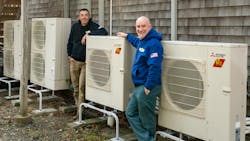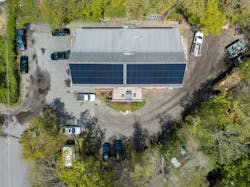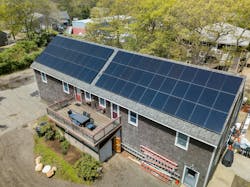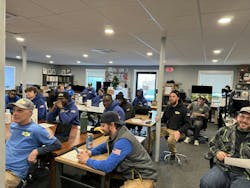Over the last 30 years, as I have progressed from plumbing apprentice in the field to Master Plumber and business owner, I have watched our industry change dramatically.
I love all things hydronic and the world of mechanical contracting. I have seen our role as mechanical contractors become more and more important in the global effort to conserve energy and water.
We serve as the voice of reason with the courage to try new things—we know what works but we are willing to learn about and install new technologies.
Three decades ago, I started in the trade installing oil boilers and baseboard fin tube piped with 3⁄4 copper tubing that I soldered together. Most equipment was oversized, but energy was cheap and climate change was not on our minds. Today’s world is completely different; we are responsible for using Manual J to correctly size the equipment, we must know and abide by ever-tightening code requirements, and we need to know which HVAC and plumbing technologies will be reliable, cost effective, and long lasting.
Decarbonization - The Wave of the Future
We are all affected by climate change—even if you don’t like baby seals and polar bears, you can appreciate how weather patterns are changing.
In response, the push for going all-electric and reducing our carbon footprint is getting stronger and stronger. Scientists, architects, politicians, code officials, and the general public are all pushing for policy, permitting, and code changes to fight climate change.
But only mechanical contractors can provide the critical insight on what approaches work, what approaches are unrealistic at the moment, and what approaches actually work in the field.
Banning fossil fuels from a city may be nice policy, but the implementation of this has significant challenges and real-world consequences that require the input of mechanical contractors.
From the Simple World of Boilers and Baseboard to the Magic of Heat Pumps
My next-door neighbor has a Smith oil-fired boiler from 1950 with a J pump—this was the flathead engine of boilers—smooth, quiet, indestructible, and 50% efficient right after you cleaned it! When oil was 25 cents a gallon it made a lot of sense...
As the price of energy rose and rose the search for alternatives to boilers became more urgent. Heat pumps became more and more appealing; their ability to collect free thermal energy made them much more efficient than an oil boiler. Because the sun would never send us a bill (I think I coined this phrase twenty years ago but I’m sure someone thought of it before me), we could spend one dollar on electricity to run the heat pump, and the sun would give us three dollars of solar energy for free, and we could heat our houses with four dollars’ worth of heat.
As more and more people became aware of heat pumps, more and more of our customers turned to us for our insight and expertise on how to use heat pumps in their buildings.
We scrambled for a bit to get up to speed on what heat pump approaches were robust and efficient, but we ultimately built our business on this expertise.
We have installed quite a few geothermal heat pump systems of all kinds (I still have DX geo at my house) and rescued quite a few poorly installed geothermal systems.
The first generation of air source heat pumps struggled in the middle of winter but over time these heat pumps became more and more efficient.
With modulation from inverter-driven compressors they now approach the efficiency of geothermal at a greatly reduced installation cost.
Heat pump water heaters had been experiments from the Jimmy Carter days—they were also in my old engineering books dating back to the 1940s—but now they have matured into a very robust and efficient way to heat domestic hot water.
The Land of Net Zero – Free Heating, Cooling, and DHW
The huge push to pivot from fossil fuels to a non-carbon future presents tremendous challenges and opportunities. What will the role of mechanical contractors be? Will we fight change or embrace it? Will we be the experts and voices of reason and progress, or will we end up on the wrong side of history?
Fortunately, there is a happy intersection of being fossil free, saving the baby seals, lower operating costs, and saving money, and that is the land of net zero!
By enlarging our vision of what an HVAC system can look like, we can provide not only the heating, cooling, and DHW production but also the means to pay for its operation. It boggles the mind, especially starting my career installing oil boilers, that we could install systems provided free heating, cooling, and DHW! Not something you can do with a fossil-fueled boiler.
NMD Net Zero Project
As forward-thinking mechanical contractors, we had to put our money where our mouths were and practice what we were preaching. Was Net Zero really realistic? Could it be done with an existing building that was built in the 1980s? Could we really power the entire building just from the free energy from the sun? What better place to demonstrate that than to make our own shop, office, and staff housing building net zero?
My business partner Dave Sprague and I bought our two story, 6,000 square foot building in 2020 as we were bursting at the seams with 25 employees at our old location. This building was built in 1982 and had a large roof, no air conditioning, and an aging propane boiler connected to baseboard fin tube—just like when I started in the trade.
On the first floor we converted the front half to office space and the rear half became our shop. There were four employee housing apartments on the second floor. The building was in good condition and the envelope was reasonably tight. We replaced the shingles on the roof to prepare for our Net Zero project.
We briefly considered solar hot water (full disclosure, I have six 4 x 10 solar hot water collectors on my home with multiple storage tanks, so I am somewhat biased) but realized we didn’t have room to store the solar input in a cost-effective way. We also knew that solar hot water couldn’t provide cooling and couldn’t compete with net metering. With net metering, any electricity generated from solar PV panels on your roof earns you a credit on your electric account that you are then able to use later when you need it. Net metering is supported in 45 states with varying restrictions on how and when you can net meter from your solar PV array.
We partnered with Cotuit Solar to get a quote for solar PV panels on the roof, their estimate of kWh annual production, and financing for the solar project. Once we had these annual kWh production numbers, we quickly realized that if we heated the building with an electric boiler at 100% efficiency, our solar PV array on the roof would cover about half of the annual operating cost. Net zero would not be possible and we would need a fossil fuel backup.
But if we installed air source heat pumps (at 300% efficiency) then the solar PV array would meet the building’s annual heating and cooling electrical needs! We would be Net Zero AND fossil free and the savings would pay for the project. Cotuit Solar installed the solar PV panels on the roof and the inverters and net metering meters to connect to the grid. Our techs installed the air source heat pumps outside and ceiling cassettes and wall units inside. We installed all electric appliances in the second-floor apartments and a heat pump water heater for DHW.
Our Net Zero project was successful because our roof was large enough (and the correct orientation to the sun) to support a solar PV array that was able to meet the annual electrical needs of our heating and cooling loads. In other situations, you might need to improve the building envelope to reduce the heating and cooling loads or have a ground mounted solar PV array with better orientation.
Both Dave and I have smaller solar PV arrays on our roofs and heat pumps for heating and cooling and DHW. Our two-employee staff houses also have heat pumps. Eventually we will install solar PV panels on those buildings as well.
Distributed Generation
Our Net Zero project is a great model of distributed generation; because we are using most of the electricity that we produce on site, the local grid can easily handle the excess that goes to my house and my business partner Dave’s house. Because grid infrastructure improvements are very expensive and a logistical and permitting struggle, distributed generation projects are often easier to get permitted. For us, developing a partnership with a local solar PV firm has been a win-win scenario. Their customers are looking for heat pumps to efficiently heat and cool their homes and our customers are looking for solar PV arrays to make their homes net zero.
Forces Moving Us Back to Hydronics
The push towards Net Zero installations is only going to grow as people realize how realistic it is. Net Zero projects seem to be most successful when heat pumps are used.
What does this mean for hydronics? Will using water to meet heating and cooling needs have a place in this approaching Net Zero world?
We have seen VRV inverter driven heat pump systems successfully compete with traditional hydronic chilled water and hot water HVAC installations.
They are very efficient but have a large refrigerant charge in all of the piping and inside units spread throughout the buildings in which they were installed.
This large refrigerant charge has now become their Achilles heel—the phasing out of R410a and replacing them with flammable refrigerants is now creating unique challenges for the use of heat pumps in buildings.
With the move towards flammable refrigerants and concerns about total refrigerant charge, I believe there will be a concerted effort to get the refrigerant out of the building envelope and use hydronic chilled and hot water distribution systems inside.
The VRV heat pump manufacturers are scrambling to develop leak detection protocols that will suck all of the refrigerant out of the inside piping and units if a leak is detected. Of course, this would mean that there would be no heating or cooling until the leak is located and repaired. A hydronic distribution system using water to deliver heating and cooling would not have this problem. We also have a tremendous amount of experience with installing and designing successful hydronic systems using the lower temperatures from air source heat pumps.
I discussed this in depth with my business partner Dave Sprague and the head of our heat pump department, Nick Lucas.
We predict that smaller net zero projects will continue to use one-to-one mini split heat pumps but that the larger residential and light commercial systems will move towards outside air to water heat pumps connected to buffer tanks with PEX water lines distributing hot and chilled water to inside units.
All of the boiler manufacturers are adding air-to-water heat pumps to their offerings—just recently Taco unveiled their System M air-to-water heat pump. Multiple other manufacturers are following suit with similar products.
In short, this means that hydronics and our expertise as modern mechanical contractors will be a critical part of any successful net zero project.
Brian Nelson is a Master Plumber and co-owner of Nelson Mechanical Design. Since 2004, NMD has been a green mechanical contractor specializing in energy- and water-efficient systems and serving the heating and cooling needs of the residents of Martha’s Vineyard.
About the Author
Brian Nelson
Brian Nelson is the co-owner of Nelson Mechanical Design, a “green” mechanical contractor serving the energy efficiency and home comfort needs of Martha's Vineyard, MA since 2004. The company designs, installs, and services just about anything to do with heating, cooling, domestic hot water, water treatment, geothermal, heat pumps, and radiant. NMD is committed to preserving the fabric of the Island it calls home. To learn more visit nmdgreen.com.





